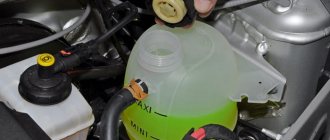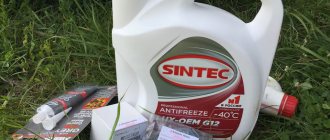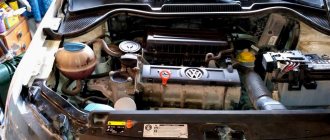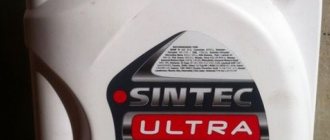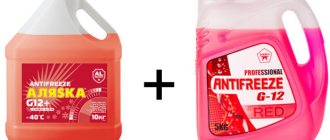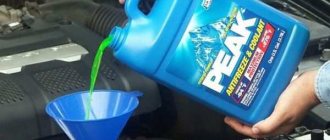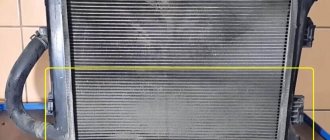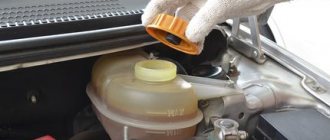Antifreeze is needed to cool a car engine. Today, coolants are classified into 4 types, each of which differs in additives and certain properties. All the antifreeze you see on store shelves is made up of water and ethylene glycol, and that's where the similarities end. So how do coolants differ from each other, in addition to color and cost, choose the right antifreeze for your car, is it possible to mix different coolants and dilute them with water - read on.
What is antifreeze?
Antifreeze is the common name for vehicle coolant. Regardless of the classification, antifreeze contains propylene glycol or ethylene glycol and its own package of additives.
Ethylene glycol is a toxic dihydric alcohol. In its pure form, it is an oily liquid that tastes sweet, its boiling point is about 200 degrees, and its freezing point is -12.5 degrees. Remember that ethylene glycol is a dangerous poison, and the lethal dose for humans is 300 grams. By the way, poison is neutralized with ethyl alcohol.
Propylene glycol is a new word in the world of coolants. Such antifreezes are used in all modern cars with strict toxicity standards; in addition, antifreeze based on propylene glycol has excellent lubricating and anti-corrosion properties. This alcohol is produced using the light phase of petroleum distillation.
Which brand of antifreeze to choose
The most rational option for choosing a coolant for a car is the technical parameters of the car, taking into account the tolerance. Each brand of car has a specific approval specification. For example:
- For a BMW car, BMW specification No. 600. 69. 0.
- For Volkswagen, the VW TL approval is 774.
- For a Ford car there is a specification FORD SSM - 97B 9102 A.
Exact data can be found in the machine’s operating manual, or from official dealers on their website.
Where and how are antifreezes used?
Antifreeze has found its application only in the field of automobile transport. It is often used in the heating system of residential buildings and premises. In our case, the main task of antifreeze is to maintain the operating temperature of the engine in a given mode. Coolant is used in a closed jacket of the engine and the line, and also passes through the passenger compartment, due to which warm air blows when the heater is on. Some cars have a heat exchanger for automatic transmissions, where antifreeze and oil intersect in parallel in one housing, regulating each other’s temperature.
Previously, cars used a coolant called “Antifreeze”, where the main requirements are:
- maintaining operating temperature;
- lubricating properties.
This is one of the cheapest liquids that absolutely cannot be used in modern cars. A number of antifreezes have already been invented for them: G11, G12, G12+(++) and G13.
G11 or G12: which to choose?
And the main question that requires a correct decision from the car owner is which antifreeze is better to use, G11 or G12, to effectively cool the engine and protect its elements? An unambiguous, correct and 100% correct answer to this question is given by the user manual from the automaker, which specifies the refrigerant that is acceptable for use in a specific vehicle model. If it is not possible to buy the original antifreeze poured into the system by the automaker from the factory, due to financial reasons or the lack of a specific type of refrigerant on the domestic market, the consumer will be able to select similar products in accordance with the classification by type of liquid specified in the manufacturer’s recommendations. It is not recommended to use type twelve refrigerant in systems whose parts contain brass and copper, which are susceptible to organic additives. Often, G11 type fluid is recommended for use in the engines of older cars, while G12 coolant is used in modern power units that have high requirements for the antifreeze to be filled.
Antifreeze G11
G11 antifreeze is produced on a classic silicate base and contains a package of inorganic additives. This type of coolant was used for cars produced before 1996 (although the tolerances of some modern cars produced before 2016 allow the use of G11), in the CIS it was called “Tosol”.
Thanks to its silicate base, G11 performs the following functions:
- creates protection for surfaces, preventing ethylene glycol from damaging them;
- slows down the spread of corrosion.
When choosing this antifreeze (its color is blue and green), pay attention to two features:
- The shelf life does not exceed 3 years, regardless of mileage. During operation, the protective layer becomes thinner; these pieces, getting into the coolant, lead to accelerated wear and tear, as well as damage to the water pump;
- the protective layer does not tolerate high temperatures, more than 105 degrees, so the heat transfer of G11 is low.
All the shortcomings can be avoided by changing the antifreeze in a timely manner and preventing the engine from overheating.
Also remember that G11 is not suitable for cars with an aluminum cylinder block and radiator, as the coolant is not able to protect them at high temperatures. Be careful when choosing budget manufacturers, such as “Euroline” or “Polyarnik”, ask for a test with a hydrometer; situations often arise when the coolant with the inscription “-40°” on the label actually turns out to be -20° and higher.
Is it possible to mix antifreezes of these series or add one antifreeze to another?
There are many rumors and legends about the possible mixing of engine cooling mixtures, which I would like to debunk once and for all. These legends can lead to engine malfunctions if you misunderstand them or follow the advice of inexperienced motorists.
For some reason, some have decided and believe that it is possible to add one antifreeze to another and mix products from one company, without taking into account the shade of the mixture. Others mistakenly think that red should only be poured into the same antifreeze, and green can only be added to green.
As it was written before, you shouldn’t rely on just the shade. The color of the cooling mixture alone cannot be considered a complete guarantee that the mixture meets safety standards.
But still, it’s definitely worth adding the same product to the car that it already has. The ideal solution would be if it is exactly the same coolant in its composition, and it was recommended by the manufacturer.
However, when mixing different types of antifreeze, certain difficulties may appear over time - this is provoked cavitation and so-called corrosion of the metal surface, it can also be blocking of motor channels and other breakdowns that can significantly reduce the engine's operating life.
- Mix antifreeze with approximately equal base (antifreeze with ethylene glycol and ethylene glycol can be mixed with each other).
- At the same time, antifreezes obtained from the silicate-free group should not be added anywhere.
- Find the most suitable product for your engine and use only this antifreeze.
Antifreeze G12, G12+ and G12++
G12 antifreeze is red or pink in color. It no longer contains silicates; it is based on carboxylate compounds and ethylene glycol. The average service life of such coolant is 4-5 years. Thanks to properly selected additives, the anti-corrosion properties work selectively - a film is created only in places damaged by rust. G12 antifreeze is used in high-speed engines with an operating temperature of 90-110 degrees.
G12 has only one drawback: its anti-corrosion properties only appear in the presence of rust.
Most often, G12 is sold as a concentrate with the mark “-78°” or “-80°”, so you need to calculate the amount of coolant in the system and dilute it with distilled water. The ratio of water and antifreeze will be indicated on the label.
Regarding G12+ antifreeze: it is not much different from its predecessor, the color is red, the improved one has become safe and more environmentally friendly. The composition contains anti-corrosion additives that work precisely.
G12++: most often purple in color, an improved version of carboxylate coolants. Lobrid antifreeze differs from G12 and G12+ in the presence of silicate additives, thanks to which the anti-corrosion properties work precisely and prevent the formation of rust.
Unknown fluid in the cooling system
Sometimes motorists simply do not know what type of coolant is used in the car. Most often, this situation arises after purchasing a used car. In this matter, you cannot simply try to guess the preferences of the former owner. Experts recommend following the following scenarios.
- If you need to fill up to 200 ml. In this case, you can safely add distilled water to the cooling system. These actions will not lead to an incorrect change in the balance of the additive composition. Essentially, you will simply add water that has boiled away due to excess pressure. Adding distilled water can be called a restorative process.
- If you need to add more than 200 ml. This need usually arises when there are problems with the radiator or system lines. The ideal solution is a complete replacement of antifreeze. All other actions will force you to hope for luck.
Antifreeze G11, G12 and G13 - what is the difference?
The question often arises: is it possible to mix different antifreezes? To do this, you need to delve into the characteristics of each coolant to understand compatibility.
The huge difference between G11 and G12 is not the color, but the key composition: the former has an inorganic/ethylene glycol base. You can mix it with any antifreeze, the main thing is that it is compatible with the class - G11.
The difference between G12 and G13 is that the second has a propylene glycol base, and the environmental safety class is many times higher.
Regarding mixing coolants:
- G11 does not mix with G12, you can only add G12+ and G13;
- G12 interferes with G12+.
G13
This type of coolant appeared in 2012. The main difference is the use of propylene glycol as a base, which has increased its environmental friendliness and safety for humans and the environment, as required by environmental standards of the European Union and other countries.
Categories of antifreeze and their properties
All three classes also differ in color, although the manufacturer can add any dye at will. As a rule, G11 is colored blue or green, G12 is red, pink, orange, G13 is purple or yellow. But we repeat that you cannot be guided only by color.
Is it possible to mix antifreeze of different brands?
In most cases, it is impossible to change antifreeze from one type to another. If the engine contains non-ferrous metals, the carboxylate included in G12 will destroy the protective film. If the question arises about mixing different types of antifreeze, then the answer is unequivocal - it’s impossible. When inorganic and organic additives are mixed, they begin to coagulate and a precipitate forms in the liquid.
If necessary, you can add antifreeze to the cooling system of the same type and marking that was in it before. In this case, you need to focus on the characteristics of the composition, and not on its color. That is, it is allowed to add either G11 to G11 based on ethylene glycol, or G12 to G12. You can change the manufacturer, but it is best to stick to the same brand. Otherwise, expect the onset of cavitation, rust, and clogging of the motor channels.
Antifreeze which company to choose
1. Tosol-Sintez is Russia’s largest manufacturer of motor oils and other auto chemicals. After the development of investments in the amount of 1 billion rubles in 2007, the product line expanded significantly: brake fluids and pads, glass washers and bulk mixtures, auto cosmetics and Felix antifreeze. High-quality goods are supplied to 15 neighboring countries.
2. Liqui Moly is a rapidly growing German company producing over 6 thousand products. Over more than half a century of development, it has earned credibility in the market of auto chemicals and motor oils - it is among the leaders in sales, selling products in 120 countries around the world. The manufacturer's antifreeze products are well-deservedly popular among motorists.
3. Motul is a famous French company founded in 1853 in New York. It produces lubricants for engines of industrial machines and vehicles, and works closely with automotive giants. Pays special attention to the environment - produces synthetic biodegradable products.
4. “Obninskorgsintez” is a young Russian company that produces auto lubricants, motor oils, and Sintec antifreezes. Sixteen years of hard work have yielded results - the manufacturer’s products are in demand not only in the Russian Federation, but also in the CIS countries.
Recommendations:
6 best brake fluids
7 best antifreezes
Legend
| Designations | Units | Names |
| ρ | g/cm3 | Density |
| pH | – | pH value |
| T s | ‒°C | Freezing point |
| T k | +°C | Boiling temperature |
| C | thousand ₽ | Price 1 kg (l) as of 01.2017 |
| Color | – | Color |
Important facts
You cannot mix G11 antifreeze with G12, even if the composition contains similar or almost the same substances. Yet there are components that are very different and make the mixture impossible to mix. Differences may occur in the presence of lubricating components
and substances with anti-corrosion properties.
Dyes simply provide antifreeze with color individuality; they are added to the composition. If the product is from a different manufacturer, but is of the same shade, it is possible to mix it with each other. Only fakes have exceptions in this regard, where the color definitions are chaotic and without features in the composition. If there is such a need to mix antifreeze, you need to buy G12 or G12+. They have the properties of a normal reaction to any other substance.
What does G12 consist of:
- ninety percent – dihydric alcohol of ethylene glycol;
- five percent – distilled water;
- at least five percent of the additive package;
- dye
see also
Antifreeze reducing additives
- 7 1 12k
Bad antifreeze is death to the engine
- 8 0 12k
Antifreeze compatibility
- 59 0 46k
Which antifreeze to choose
- 17 0 34k
How to add antifreeze
- 152 2 144k
Antifreeze is a coolant based on ethylene or propylene glycol, translated “Antifreeze”, from international English as “non-freezing”. Antifreeze class G12 is intended for use on cars from 1996 to 2001; modern cars, as a rule, use antifreeze 12+, 12 plus plus or g13.
“The key to stable operation of the cooling system is high-quality antifreeze”
Connectivity
It is not recommended to add liquids with different indicators to each other.
. And this applies to all oils, antifreeze and other substances. As for g11 and g12, when they are combined, two negative points are observed:
- G12 loses its properties both when added to G11 and when G11 is added to it. The crust formed by 11 antifreeze prevents the action of the more advanced G12, so overpaying for a more modern antifreeze is in vain;
- If the antifreezes are also from different manufacturers, no one can predict the consequences of combining them. There have been cases when antifreeze additives reacted with each other so actively that jelly literally formed in the cooling system.
If the situation is really bad, and there is nowhere to retreat, you can risk adding another antifreeze to one, hoping to only get a loss in the qualities of G12. That is, try to find at least antifreeze from the same manufacturer in a force majeure situation. However, upon reaching the end of the journey, the system will need to be thoroughly rinsed and the indistinct compote replaced with a homogeneous antifreeze that you use constantly. The same applies to the case when you intend to improve the quality of the coolant being poured.
Realizing the difference between G11 and G12 antifreezes, a caring owner would rather carry a certain supply of native antifreeze with him than pour a foreign one into the car. After all, a bottle of antifreeze does not take up much space in the trunk.
How to cool the engine?
For this purpose, special substances called antifreeze are used, which have a low viscosity temperature. This sets them apart from plain water, which can damage individual components if the temperature outside is below zero.
Antifreeze is a thing of the past, now modern engines are cooled by ANTIFREEZE
Until recently, all liquids that are designed to cool the engine were called “antifreeze,” but now people have begun to distinguish between different types of antifreeze. In general, there are salt- and acid-based options. And so that car enthusiasts do not confuse them with each other, they are all painted in different colors. In the case of saline solutions, we can see a blue or green tint, while acidic solutions have a characteristic red color.
The choice of a specific type of antifreeze depends on what materials the manufacturer worked with when creating the engine cooling system.
Antifreeze G11 - almost antifreeze, only with additives
The liquid component of antifreeze is a substance called ethylene or polypropylene glycol.
Since the first of these two components has an increased level of toxicity, most manufacturers opt for the second option. So, you cannot mix different types of these liquids. And, if it is necessary to replace antifreeze, it must be completely drained from the system and replaced with a new one.
